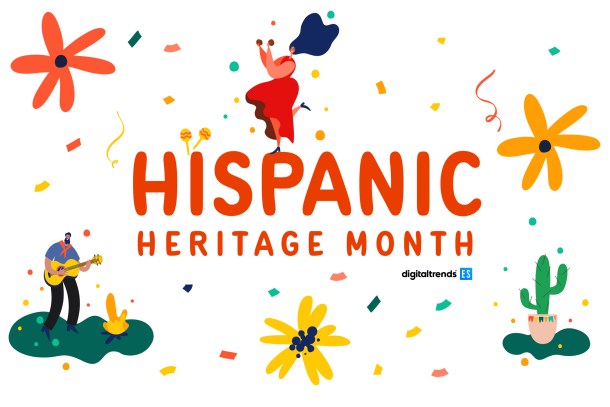Each year, Hispanic Heritage Month is celebrated in the United States, beginning on September 15 and ending on October 15. Established in 1968, the celebration seeks to recognize the contributions and achievements of the Latin American community in this country.
- Diana Trujillo, from NASA
- Brenda Salinas, from Google
- Kety Esquivel, from McCarson Consulting
- Lilian Rincón, from Google
- Nina Vaca, from Pinnacle Group
- Angeles Elena Van Ryzin, from Kia
- Sandra L. Rivera, from Intel
- Blanca Treviño, from Softtek
- Ana Corrales, from Google
- Edaena Salinas, from Microsoft
- Rocío van Nierop, from Latinas in Tech
At Digital Trends, we want to highlight those Latinas who have an important influence on the technology sector.

Diana Trujillo, from NASA

Aerospace engineer Diana Trujillo always wanted to be part of NASA and she succeeded. Since her childhood in Cali, Colombia, she dreamed of reaching the stars, and now she is part of Mars 2020. She works with the group that designed and examined the robotic arm and two instruments for the mission, which seeks to demonstrate whether there was life on the red planet. She has been a member of the Goddard Space Flight Center and the Jet Propulsion Laboratory.
Brenda Salinas, from Google

She defines herself as “regio-montana” by birth, but Texan by choice. The truth is that Salinas is committed to building a media landscape in which every woman of color has the power to tell her story. She helped relaunch NPR’s Latino USA as a full hour program and is currently a Google audio content strategist.
Kety Esquivel, from McCarson Consulting

She strongly believes in the good that technology can bring to the world. The daughter of a Guatemalan mother and a Mexican father, she considers herself an American, Guatemalan, Mexican, and Latina. She has a consulting business, and in her previous role as vice president of marketing and communications at AnitaB.org, she empowered women to use technology as a means to achieve representation for the majority of the population. We invite you to read the interview with her about her previous role at AnitaB.org.
Lilian Rincón, from Google

Of Venezuelan origin, she is the leader of Google Assistant, where she manages the team that creates new features and functions for this platform. When she was nine years old, her family decided to move from Venezuela to Canada; she did not speak English, so she could not talk to many people at school, however, she found a kind of universal language in mathematics. Focused on the technology industry and always versed in artificial intelligence and machine learning, she previously spent six years at Skype.
Nina Vaca, from Pinnacle Group

Born in Ecuador, since she was a child she realized how technology completely changed the business of her immigrant parents, who had started it when they arrived in the United States. Since then, she understood that technology was an ally of progress. For 24 years, she built her empire, Pinnacle Group, one of the largest Latino companies in the country. Throughout her life, she has promoted education in science, technology, engineering, and mathematics through scholarships and programs, which can benefit Hispanics in Dallas, Texas, and children in her native Ecuador.
Angeles Elena Van Ryzin, from Kia

Originally from Zacatecas, Mexico, Van Ryzin was one of the women responsible for the Kia Telluride. Her work consisted of achieving the vehicle’s ease of driving and fuel efficiency. She earned a professional degree in Mechanical Engineering and is passionate about the subject of mobility. “Being a woman is not a limitation to do any work,” is one of the ideas she promotes. She also feels great satisfaction when the SUV, which she helped develop, is on the streets of the United States.
Sandra L. Rivera, from Intel

Hispanic Sandra L. Rivera, vice president of personnel at Intel Corporation, is responsible for driving better business results through a culture that embraces diversity and inclusion. Before assuming her current position, she led the Network Platforms Group and was one of the leaders in making the 5G network a reality in Intel’s plans. The Colombian-rooted executive has done much to make connectivity faster and more efficient.
Blanca Treviño, from Softtek

She was ranked by Forbes magazine as “one of the 10 most powerful women in Mexico”. Looking at her record, it is not difficult to understand why. She is the founder and president of Softtek since 2000, a Mexican information technology company that has grown exponentially under her leadership. The firm is present in four continents and has 12,000 employees.
Ana Corrales, from Google

She is the director of consumer hardware operations at Google, where she oversees the detailed development and delivery process for products such as the Pixel 4 phone and Nest Mini speakers. Recently, she supported many of the company’s community efforts in response to COVID-19. She is originally from Costa Rica.
Edaena Salinas, from Microsoft

Originally from Monterrey, Mexico, Edaena Salinas has been a software engineer at Microsoft since 2014. She also created The Women in Tech Show, a podcast about what we work on, not what it feels like to be a woman in technology,” and in which she has developed — through interviews with different leaders — topics such as technology, science, research, and entrepreneurship. She strongly believes that Latinas should explore careers in science and technology because it opens many doors.
Rocío van Nierop, from Latinas in Tech

Co-founder of the Latinas in Tech project and former Director of Product Marketing at Prezi, she has been an advocate for technological inclusion. Latinas in Tech aims precisely at connecting, supporting, and empowering Latina women working in the technology industry, so she works hand in hand with leading firms to create safe spaces for learning, mentoring, and recruiting. Van Nierop has Mexican parents, grew up in Mexico, Germany, France, and Boston, and enjoys extreme sports.



